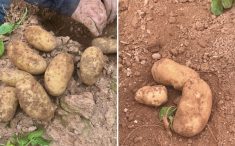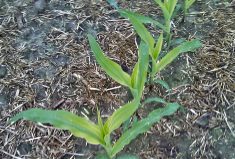It’s undeniable that interest in cover crops has taken off in the past two or three years. Red clover is making a comeback, there’s more being done with multi-species covers, and there’s renewed interest in seeding covers into standing corn crops.
There’s even more research into using cover crops as emergency forage sources.
Now comes another “return to yesterday.” The practice of seeding cover crops with manure is making a comeback, and it’s getting a hard look especially by growers interested in establishing cover crops following corn silage.
Read Also

Could crop sharing be a viable option for your farm?
Crop sharing could be a good option for young and beginning farmers.
The principle is the same as with any cover crop: protect the soil while adding some nitrogen for the following crop. But the addition of manure after corn silage provides the added benefit of sequestering more nutrients — not just nitrogen, but phosphorus, potassium and several micronutrients — for the rotation.
It’s a tricky proposition, but one that Scott Banks acknowledges has been tried before. As emerging crops specialist with the Ontario Ministry of Agriculture, Food and Rural Affairs (OMAFRA), Banks says there are several considerations, including what kind of cover crop is being planted, the specific timing and even the method of planting.
There is also the growth of the silage-specific portion of the corn sector. In the past 10 years, seed companies such as Mycogen have made significant inroads into the silage market, convincing many livestock producers to invest in a specific silage hybrid. That counters conventional thinking on so-called multi-functional hybrids where growers take a portion of their regular crop early for silage and leave the rest to dry down as grain corn.
When it comes to applying manure with a cover crop, Banks concedes there’s really nothing new about the approach. Growers were doing something similar decades ago. But there has been a big change in the cover crop species that can be planted.
Red clover is certainly on the rebound, says Banks, and oilseed radish has carved out a strong niche among many growers. There are even some who are trying cereal rye or annual rye in August into standing corn, using high-clearance sprayers to broadcast in between the rows.
But it’s the manure-cover-crop combination following corn silage that’s an intriguing concept, although one that still must be carefully managed. Covers and manure following a cereal crop — even a late-spring cereal crop as in 2014 — are far more common, and offer more time to grow before winter.
“Years ago, there were some guys doing covers and manure after corn to some degree,” says Banks, acknowledging that it worked best in years when the silage crop comes off a little earlier than usual, perhaps at the end of August. (In 2014, conditions just didn’t offer that window.)
“But I do know that the guys who used to do it tended to be on the lighter soils, and it’d be a bit of protection for the soil as well. They’d put in cereal rye which was the predominant choice, and they’d take a cut of forage grass off it going into late fall, just before freeze-up. If they got it before the frost, it’d make some pretty good feed quality in that kind of a system where they’re backgrounding some calves, and it makes a nice mix with the feed.”
Timing is everything
The primary issue with corn silage and the cover crop-manure blend is simply timing. Some may argue that the late-September planting of a cover crop with a manure application defeats the purpose of keeping the soils growing; it’s too late in the year to establish a good stand, be it clover, rye or oilseed radish. But that seems to be less of an issue for Banks, who says the real issues are the cost of seed, the cost of planting (versus broadcasting) and assessing the amount and value of nutrient sequestering.
“Some growers have done the manure and covers together, but it tends to be more with cover crops like oilseed radish or some of the smaller, harder-seed covers that they’ve used in the past,” says Banks. “Things such as oats or some of those bigger, bulkier seeds — I haven’t tried putting them in the manure and agitating them and putting them on, but cover crops like oilseed radish (in manure) are similar to the days where we’d feed trefoil seed to beef cattle on pasture. It’s the same concept but a different approach and timing.”
As for getting the cover crop into the ground, Banks says broadcasting is the usual method, but in an ideal situation, a farmer would drill in a cover crop, except for the added expense. Seed cost is the other factor. If you’re using inexpensive seed, you may be better able to afford the loss of some seed with broadcasting and cultivating it in.
“The biggest challenge is having a cover crop that will hold the nutrients, particularly the nitrogen,” says Banks. The primary focus is capturing nitrogen and keeping it from leaching into the ground or volatilizing to the air. Then there’s the issue of releasing it at the right time.
The other consideration is the rate of nutrient release by different cover crops. Red clover has come back as the best of the covers, but oilseed radish is a rapid-growth cover with lots of biomass. That can become an issue where such lush growth can break down very easily, leaving less residue and the potential for the “too-soon” release of nitrogen for a subsequent crop. There’s a significant savings or cost from that release of nitrogen, says Banks. Work done on cover crops indicates that 50 to 60 lbs. per acre of N should be applied to a crop, and at $0.50 per pound of N, that’s $25 to $30 per acre from the manure alone, plus phosphorus, potassium, micronutrients and organic matter.
“We still find that you don’t capture the full value of that nitrogen with things like oilseed radish because it releases it too soon,” says Banks, adding that the timing for red clover works better for the following year’s corn crop. “But it does certainly help, and anything you can do to build up organic matter will also help capture that nitrogen and release it over time. As for the other nutrients, those crops certainly help take them up and release them again over time, so particularly with phosphorus but even with potassium and some of the micros, it will tie them up and bring them into the whole system over time, as well.”
Banks understands there are more growers looking at cover crops, perhaps matching them with manure applications, and potentially using that combination with post-harvest of silage corn. He acknowledges too that there actually is a window of opportunity, and he believes we’ll see such a practice being adopted on a larger scale in the next few years.
The interesting thing about this is that it’s not so much a regional practice. Cover crops are a province-wide trend — as is applying manure. But getting the most out of the soil and returning nutrients to the soil are not limiting factors for growers.
“I always thought that window was too short,” says Banks. “So it’s certainly interesting to see what growers can do to try to protect their soils.”
















